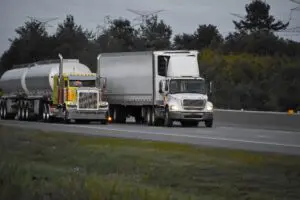The gap between the average age of truck drivers and the minimum age required to enter the sector reveals a significant barrier to attracting younger individuals.
The American Transportation Research Institute (ATRI) has published new research titled “Demographic Evolution of Truck Drivers: Issues and Opportunities,” which highlights a significant shift in the demographic composition of American truck drivers.
The study examines how broader social and labor trends are reshaping the road transport sector. It also offers strategies for logistics companies to recruit younger, more diverse, and historically underrepresented populations. One of the key topics discussed is the urgent need to attract younger drivers. Let’s delve deeper into this issue.

The lack of young drivers in the industry: what do the statistics say?
One of the most notable aspects of the ATRI’s research is the age of drivers in the road transport industry. The gap between the average age of truck drivers and the minimum age required to enter the sector reveals a significant barrier to attracting younger individuals. According to 2023 government data, the average age of truck drivers is 47, compared to an average age of 42 for the overall U.S. workforce.
This positions truck drivers closer to the average retirement age of 67, highlighting one of the most discussed issues in the industry in recent years: high employee turnover.
The report identifies four main generations in the road transport workforce:
- Baby Boomers – born between 1946 and 1964
- Generation X – born between 1965 and 1980
- Millennials – born between 1981 and 1995
- Generation Z – born between 1996 and 2010
Generation X represents 40.8% of truck drivers, making it the most represented generation. As 20.7% of the driver workforce, represented by Baby Boomers, moves toward retirement, the industry must continue to find strategies to engage both Millennial drivers (30.7%) and Generation Z drivers (7.5%), as these two generations make up nearly half of the U.S. workforce as of 2023, according to ATRI.
By turning to younger individuals, the sector can build a sustainable driver workforce. This is why early driving experience plays a crucial role in developing safe driving habits. Unfortunately, barriers such as education and training to obtain a CDL limit access for many young people.

Recruitment programs and alignment with young drivers’ expectations
The percentage of 16-year-olds without a driver’s license has risen from 69% in the early 2000s to 75%, reflecting a broader trend of more teenagers and young adults opting not to obtain a driver’s license.
According to the Southern Dallas Driving Academy (SDDA), a workforce development program for youth in urban areas, 39% of urban residents in poverty in the U.S. lack a valid driver’s license. Programs like the SDDA offer a critical opportunity for young people in urban areas to access professional careers in the road transport sector.
On the other hand, the industry must find recruitment options that align with young drivers’ expectations. While compensation is a key factor in attracting younger drivers, previous ATRI research found that 60% of younger drivers consider other factors, aside from salary, to be equally or more important. These include a stable career path, a love for driving, and a healthy work-life balance. Additionally, 84% of younger drivers value a positive company culture, defined by supportive bosses, close relationships among peers, and a clear understanding of each person’s role.
To foster retention, ATRI suggests implementing apprenticeship programs, clear communication about long-term earning potential, and creating open channels for continuous communication within the company.

World Smile Day: benefits of sharing a smile
World Smile Day is celebrated on the first Friday of October, so let’s do an act of kindness and help one person smile. World Smile

Massive fire at Chevron refinery sparks safety concerns and fuel price fears
A massive fire broke out at Chevron’s refinery in El Segundo, the largest oil production facility on the West Coast. On the night of October

MEET operation: 82 commercial vehicles inspected at the Wyoming-Colorado border
The MEET operation, a traffic enforcement operation targeting CMVs, was carried at the Wyoming and Colorado border. A traffic enforcement operation targeting commercial motor carriers,

Road safety reforms: coalition demands for results
The Truck Safety Coalition (TSC) calls for road safety reforms following deadly truck crash report. The Truck Safety Coalition (TSC) is calling for safety reforms

DOT suspends federal funding in New York amid civil rights review
U.S. DOT announces interim final rule banning race- and sex-based contracting requirements in federal grants. The U.S. Department of Transportation (DOT) has issued a statement

U.S. government shutdown begins: how will the transportation industry be affected?
A U.S. government shutdown began a shutdown on October 1, 2025, but the Department of Transportation released its operational plan. The U.S. government shutdown began
